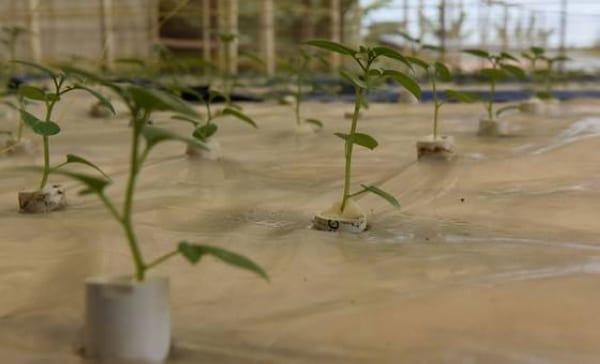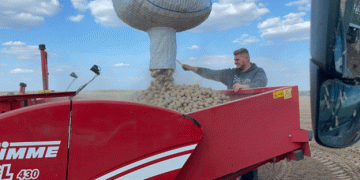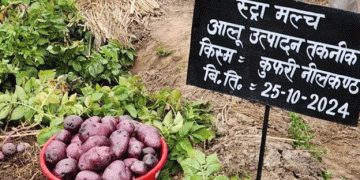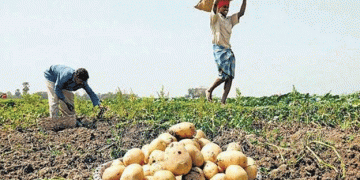KIGALI — Agriculture is embedded in the culture of the people of Rwanda. In fact, about 67 percent of Rwandans are employed in agriculture, with arable land covering over 1.56 million hectares of the country.
But with Rwanda’s population set to rise from 10.5 million in 2012 to 16.9 million by 2032, demand for food will likewise soar. At the same time, the amount of arable land is likely to diminish with the country’s cities steadily expanding. Agricultural innovations, that focus on ensuring higher productivity in smaller spaces, are needed if Rwanda’s agricultural sector is to continue meeting the food needs of the country. Enter a new way of growing food without soil and less water: aeroponics.
Aeroponics is a climate-friendly way of planting in which roots are suspended in the air and grow in a humid environment. No soil is involved. Instead, the plants are sprayed with water and nutrient solution. This technique enables farmers to control humidity, temperature, pH, and water conductivity inside a greenhouse.
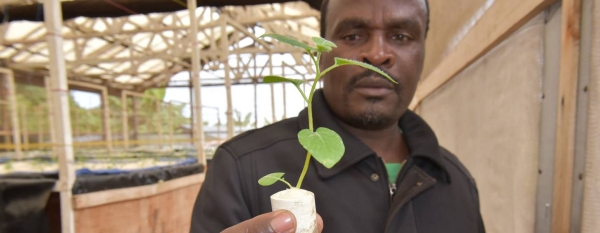
Meet the pioneer
When Apollinaire Karegeya found out about aeroponics, he recognized that it could increase food production and do so in a sustainable way. Apollinaire comes from a family of potato farmers, who have always practiced traditional farming. But with low crop productivity due to the climatic conditions, he knew the difficulties of providing a secure source of food for his local community. Apollinaire was hungry for new skills and knowledge that he could use to improve his farm.
“I started going to government partners who were working with the farmers in the country. One day one of the government partners offered me a training opportunity in Europe. That is when I first encountered aeroponics,” Apollinaire says.
“I was amazed by this soilless technology. It prevents diseases and increases productivity. After the week-long training, I was convinced that this was going to be good.”
Innovation, innovation, innovation!

With further support from the government and its partners, Apollinaire began farming potatoes through greenhouse aeroponics in 2015 and has been a pioneer of the aeroponic system in Rwanda ever since. Through aeroponics, he now multiplies potato seedlings, some of which he then plants on his farm to grow potatoes, and others which he sells to other farmers to plant on their farms. Apollinaire grows about 2 500 plantlets in his greenhouse, which produces potatoes in 2.5 months.
“Since it is not rotational farming, I grow three times a year. When the nutrients are well regulated, you can be assured of the yield. This wasn’t the case with growing in open fields where you’re at the mercy of nature,” he says.
When Apollinaire first started using this technology, he still had a lot to learn.
“Tubers grown from aeroponics are kept for four months before they can be transferred to gardens. I lacked storage facilities, and along the way, some potato seedlings would rot,” said Apollinaire.
In 2018, FAO, with funds from the European Union, implemented a project to improve the livelihoods of small producers engaged in the roots and tubers value chains. It aimed at making production more efficient and linking smallholders to domestic and regional markets.
Through the project, Apollinaire was trained in improved potato storage techniques and how to work with financial institutions to boost his new business further. He learned to keep the potato seedlings in boxes when they are ready to be moved to soils so that they get enough air as they wait to be picked up by buyers.
Convincing Rwandans about the new way of farming
Growing food without soil is new to many Rwandans, so Apollinaire also faced the challenge of changing mindsets. With help and training from FAO, he began to use the media including radio, television, newspapers, and websites to spread the word.
“The training opened my eyes to use community radios to raise awareness about my business and also the aeroponics systems. From then on, the demand for my seedlings grew exponentially. I receive many farmers asking me to help them set up the aeroponics system,” he said smiling.
Now, he is so overwhelmed with customers that he is trying to encourage more people to adopt aeroponic methods and produce seedlings for Rwandan farmers.
Apollinaire has also trained his 20-year-old son in aeroponics, as well as 42 other farmers in Rwanda. As more farmers hear about the new farming techniques through Apollinaire’s media outreach, he believes it will increase food production. Eventually, farmers will be able to use aeroponics to grow other kinds of crops, such as vegetables.
“The Rwandan population is increasing. We have to think of technologies to increase the amount of food we produce. New innovations are changing the image of agriculture. More youth are attracted to engage in agribusiness because it’s no longer that backbreaking sector,” he said.
With populations increasing and cities expanding around the world, innovative farming methods are exactly what’s needed to reinvigorate the agriculture sector. By encouraging more farmers to follow in Apollinaire’s footsteps, we can increase food security in a climate-friendly, sustainable way for all. — Courtesy FAO
